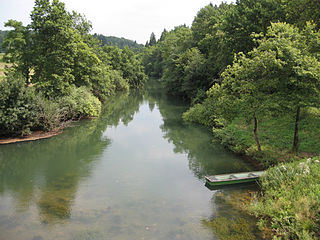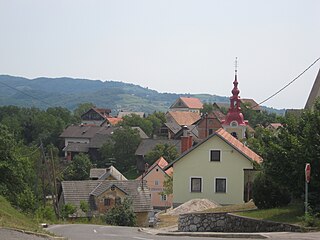| Klošter | |
|---|---|
| Coordinates: 45°37′3.66″N15°14′23.16″E / 45.6176833°N 15.2397667°E Coordinates: 45°37′3.66″N15°14′23.16″E / 45.6176833°N 15.2397667°E | |
| Country | |
| Traditional region | White Carniola |
| Statistical region | Southeast Slovenia |
| Municipality | Metlika |
| Area | |
| • Total | 0.71 km2 (0.27 sq mi) |
| Elevation | 156.7 m (514.1 ft) |
| Population (2002) | |
| • Total | 80 |
| [1] | |
Klošter (pronounced [ˈkloːʃtəɾ] ; German : Kloster [2] ) is a settlement on the left bank of the Lahinja River in the Municipality of Metlika in the White Carniola area of southeastern Slovenia. The entire area is part of the traditional region of Lower Carniola and is now included in the Southeast Slovenia Statistical Region. [3]

German is a West Germanic language that is mainly spoken in Central Europe. It is the most widely spoken and official or co-official language in Germany, Austria, Switzerland, South Tyrol (Italy), the German-speaking Community of Belgium, and Liechtenstein. It is also one of the three official languages of Luxembourg and a co-official language in the Opole Voivodeship in Poland. The languages which are most similar to German are the other members of the West Germanic language branch: Afrikaans, Dutch, English, the Frisian languages, Low German/Low Saxon, Luxembourgish, and Yiddish. There are also strong similarities in vocabulary with Danish, Norwegian and Swedish, although those belong to the North Germanic group. German is the second most widely spoken Germanic language, after English.

The Lahinja is a river in White Carniola, the extreme southeastern part of Slovenia. It is 34 kilometres (21 mi) long and originates from several karst springs at the end of a steephead valley between the villages of Knežina, Belčji Vrh, and Mali Nerajec.

A municipality is usually a single administrative division having corporate status and powers of self-government or jurisdiction as granted by national and regional laws to which it is subordinate. It is to be distinguished (usually) from the county, which may encompass rural territory or numerous small communities such as towns, villages and hamlets.
The local church, built north of the settlement, at the confluence of the Krupa with the Lahinja, is dedicated to the Virgin Mary and belongs to the Parish of Podzemelj. It was built in the second half of the 15th century and was remodelled in the Baroque syle when it was extended in the 17th century. The belfry was added in 1828. [4]

A church building or church house, often simply called a church, is a building used for Christian religious activities, particularly for Christian worship services. The term is often used by Christians to refer to the physical buildings where they worship, but it is sometimes used to refer to buildings of other religions. In traditional Christian architecture, the church is often arranged in the shape of a Christian cross. When viewed from plan view the longest part of a cross is represented by the aisle and the junction of the cross is located at the altar area.

Mary was a 1st-century BC Galilean Jewish woman of Nazareth, and the mother of Jesus, according to the New Testament and the Quran.
A parish is a territorial entity in many Christian denominations, constituting a division within a diocese. A parish is under the pastoral care and clerical jurisdiction of a parish priest, who might be assisted by one or more curates, and who operates from a parish church. Historically, a parish often covered the same geographical area as a manor. Its association with the parish church remains paramount.






